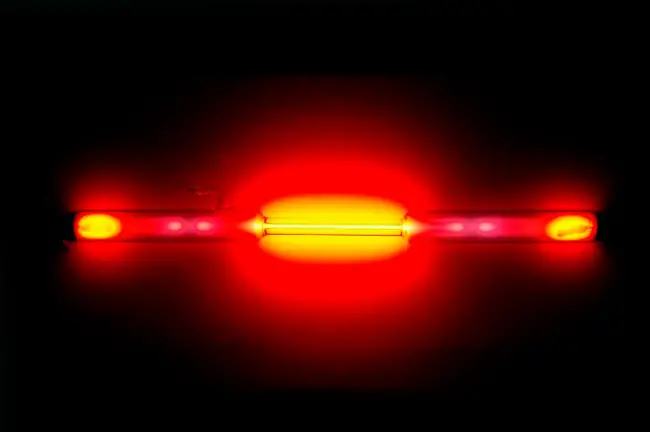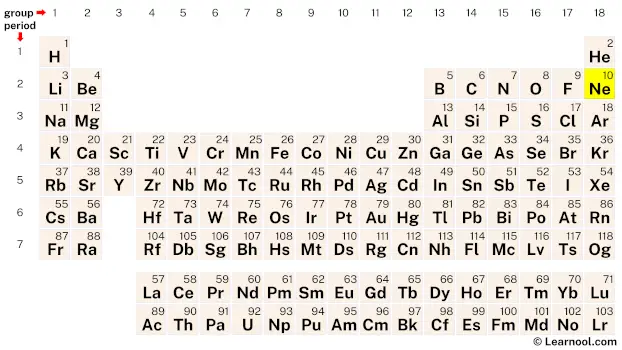
Neon (Ne) is a chemical element of the periodic table, located in the group 18 and the period 2, and is having the atomic number 10. It is a colorless, odorless, tasteless, non-toxic gas, whose name comes from the Greek word “neos”, which means new. It is a member of the noble gas group.
On periodic table
| group | ⇨ | 1 | 2 | 3 | 4 | 5 | 6 | 7 | 8 | 9 | 10 | 11 | 12 | 13 | 14 | 15 | 16 | 17 | 18 |
| period | ⇩ | ||||||||||||||||||
| 1 | 1 H  Hydrogen |
2 He  Helium |
|||||||||||||||||
| 2 | 3 Li  Lithium |
4 Be  Beryllium |
5 B  Boron |
6 C  Carbon |
7 N  Nitrogen |
8 O  Oxygen |
9 F  Fluorine |
10 Ne Neon |
|||||||||||
| 3 | 11 Na  Sodium |
12 Mg  Magnesium |
13 Al  Aluminium |
14 Si Silicon |
15 P  Phosphorus |
16 S  Sulfur |
17 Cl  Chlorine |
18 Ar  Argon |
|||||||||||
| 4 | 19 K  Potassium |
20 Ca  Calcium |
21 Sc  Scandium |
22 Ti  Titanium |
23 V  Vanadium |
24 Cr  Chromium |
25 Mn  Manganese |
26 Fe  Iron |
27 Co  Cobalt |
28 Ni  Nickel |
29 Cu  Copper |
30 Zn  Zinc |
31 Ga  Gallium |
32 Ge  Germanium |
33 As  Arsenic |
34 Se  Selenium |
35 Br  Bromine |
36 Kr  Krypton |
|
| 5 | 37 Rb  Rubidium |
38 Sr  Strontium |
39 Y  Yttrium |
40 Zr  Zirconium |
41 Nb  Niobium |
42 Mo  Molybdenum |
43 Tc  Technetium |
44 Ru  Ruthenium |
45 Rh  Rhodium |
46 Pd  Palladium |
47 Ag  Silver |
48 Cd  Cadmium |
49 In  Indium |
50 Sn  Tin |
51 Sb  Antimony |
52 Te  Tellurium |
53 I  Iodine |
54 Xe  Xenon |
|
| 6 | 55 Cs  Caesium |
56 Ba  Barium |
72 Hf  Hafnium |
73 Ta  Tantalum |
74 W  Tungsten |
75 Re  Rhenium |
76 Os  Osmium |
77 Ir  Iridium |
78 Pt  Platinum |
79 Au  Gold |
80 Hg  Mercury |
81 Tl  Thallium |
82 Pb  Lead |
83 Bi  Bismuth |
84 Po  Polonium |
85 At  Astatine |
86 Rn  Radon |
||
| 7 | 87 Fr  Francium |
88 Ra  Radium |
104 Rf  Rutherfordium |
105 Db  Dubnium |
106 Sg  Seaborgium |
107 Bh  Bohrium |
108 Hs  Hassium |
109 Mt  Meitnerium |
110 Ds  Darmstadtium |
111 Rg  Roentgenium |
112 Cn  Copernicium |
113 Nh  Nihonium |
114 Fl  Flerovium |
115 Mc  Moscovium |
116 Lv  Livermorium |
117 Ts  Tennessine |
118 Og  Oganesson |
||
| 57 La  Lanthanum |
58 Ce  Cerium |
59 Pr  Praseodymium |
60 Nd  Neodymium |
61 Pm  Promethium |
62 Sm  Samarium |
63 Eu  Europium |
64 Gd  Gadolinium |
65 Tb  Terbium |
66 Dy  Dysprosium |
67 Ho  Holmium |
68 Er  Erbium |
69 Tm  Thulium |
70 Yb  Ytterbium |
71 Lu  Lutetium |
|||||
| 89 Ac  Actinium |
90 Th  Thorium |
91 Pa  Protactinium |
92 U  Uranium |
93 Np  Neptunium |
94 Pu  Plutonium |
95 Am  Americium |
96 Cm  Curium |
97 Bk  Berkelium |
98 Cf  Californium |
99 Es  Einsteinium |
100 Fm  Fermium |
101 Md  Mendelevium |
102 No  Nobelium |
103 Lr  Lawrencium |
|||||
| – p block |
Neon is a p-block element, situated in the eighteenth column and the second row of the periodic table. Its atomic number is 10 and its symbol is Ne.
Element information
 |
|
 |
|
| Origin of name | Greek word “neos” (which means new) |
| Symbol | Ne |
| Atomic number (Z) | 10 |
| Atomic mass | 20.1797 u |
| Block | p-block |
| Group | 18 |
| Period | 2 |
| Classification | Noble gas |
| Covalent radius | 58 pm |
| Van der Waals radius | 154 pm |
| Melting point | -248.59 ℃, -415.46 ℉, 24.56 K |
| Boiling point | -246.046 ℃, -410.883 ℉, 27.104 K |
| Electron configuration | [He] 2s2 2p6 |
| Learn how to write: Neon electron configuration | |
| Electrons per shell | 2, 8 |
| Learn how to draw: Neon Bohr model | |
| Crystal structure | Face-centered cubic (fcc) |
| Phase at r.t | Gas |
| Density near r.t | 0.9002 g/L |
| Main isotopes | Neon-20, Neon-21, Neon-22 |
| Natural occurrence | Primordial |
| Oxidation state | 0 |
| Protons Neutrons Electrons |
10 10 10 |
| Learn how to find: Neon protons neutrons electrons | |
| Valence electrons | 8 |
| Learn how to find: Neon valence electrons | |
| CAS number | 7440-01-9 |
| Discovered by | William Ramsay and Morris Travers in 1898 |
History
The discovery of neon is credited to two British chemists, Sir William Ramsay and Morris W. Travers. In 1898, the two scientists were conducting experiments on liquefied air when they discovered a gas that didn’t react with any other substances. They named this gas “neon” from the Greek word “neos,” meaning new.
Ramsay and Travers went on to isolate neon and four other noble gases, helium, argon, krypton, and xenon, from liquefied air. These noble gases were previously unknown and their discovery was a significant breakthrough in the field of chemistry. Ramsay was awarded the Nobel Prize in Chemistry in 1904 for his work on the discovery of the noble gases, including neon.
Neon was first used commercially in neon lighting in 1910, and its popularity quickly grew due to its bright and distinctive colors. Today, neon lighting is still used for advertising and decorative purposes, but other uses for neon have also been developed.
Occurrence and production
Neon is a rare gas in the Earth’s atmosphere, present at a concentration of about 18.2 ppm by volume. It is fifth in cosmic abundance after hydrogen, helium, oxygen, and carbon. Despite its rarity, neon is an abundant element in the universe and is produced by stars.
Neon is produced by the process of air liquefaction. In this process, air is cooled and compressed to liquefy the gases in it. The liquefied air is then separated into its individual components using a process called fractional distillation. The process separates the different components of air based on their boiling points. Neon has the lowest boiling point of all the components of air, and so it is collected in the first stage of the distillation process. The collected neon is then purified by passing it through activated charcoal, which removes any impurities. The purified neon is then stored in high-pressure cylinders for transportation and use.
Neon can also be produced through the process of nuclear transmutation, where it is formed by the bombardment of lighter elements with high-energy particles. However, this method of production is not economically viable for commercial production of neon, and is mainly used for scientific research purposes.
Properties
Physical properties
Neon is a colorless, odorless, and tasteless gas.
It is the second lightest noble gas after helium, with a density of 0.9 grams per liter.
It has a melting point of -248.59 ℃ and a boiling point of -246.046 ℃.
Neon is a very stable element and does not react with other elements or compounds.
Chemical properties
Neon is a noble gas and is inert, meaning it does not readily react with other elements or compounds.
It has a very low electronegativity, meaning it does not readily form bonds with other elements.
Neon has eight electrons in its outer shell, making it a very stable element.
Other properties
Neon is commonly used in lighting due to its bright and distinctive orange-red glow when excited by an electrical discharge.
It is also used in cryogenics, as it has the lowest boiling point of all the noble gases and can be used to achieve very low temperatures.
Neon is a rare gas in Earth’s atmosphere, making up only 0.0018% by volume. It is extracted by fractional distillation of liquid air.
Applications
Lighting
One of the most common applications of neon is in lighting. Neon lights, also known as gas-discharge lamps, are used in advertising signs, indicator lights, and even art installations. When an electrical discharge is passed through the gas, it emits a bright red-orange light.
Cryogenics
Neon is used as a cryogenic refrigerant, which means it is used to cool objects to extremely low temperatures. Its boiling point is just a few degrees above absolute zero, making it ideal for use in cryogenic applications.
Medical imaging
Neon is used in medical imaging equipment, such as MRI machines, to cool the superconducting magnets used in the imaging process. The low-temperature properties of neon make it an ideal coolant for these applications.
Laser technology
Neon is often used as a lasing medium in gas lasers. When excited by an electric discharge, the gas emits light of a specific wavelength, which can be amplified by a laser cavity to create a high-intensity beam of light.
Welding
Neon is also used in welding, particularly in the production of high-frequency welding equipment. When excited by an electric discharge, neon can be used to produce high-voltage, high-frequency oscillations that are used in the welding process.
Research
Neon is used in various research applications, such as in studies of the properties of matter at extremely low temperatures, and as a tracer gas to study the flow of fluids in geological formations.
Interesting facts
Neon is one of the noble gases and is the second-lightest noble gas after helium. It is also the second most abundant element in the universe after hydrogen.
The name “neon” is derived from the Greek word “neos,” meaning “new.”
Neon was discovered in 1898 by Sir William Ramsay and Morris Travers in London, England.
Neon is used in neon signs, which were first introduced in the early 1900s and quickly became popular due to their bright and eye-catching colors.
Neon is also used in gas lasers, high-voltage indicators, television tubes, and as a coolant in nuclear reactors.
Neon is known for its distinctive red-orange glow when electrically charged, which makes it a popular choice for decorative lighting.
Neon has no known biological role or toxicity, and is considered to be non-toxic and chemically inert.
Neon is the first element to have its entire spectrum observed and measured by astronomers, allowing for better understanding of the composition of stars.
The characteristic bright colors of the aurora borealis and aurora australis are caused by charged particles colliding with atmospheric gases, including neon.
Neon is an important element in the study of plasma physics and is used in plasma displays, which are found in televisions, computer monitors, and other electronic devices.
Related
More elements
External links
- https://www.rsc.org/periodic-table/element/10/neon
- https://www.britannica.com/science/neon-chemical-element
- https://en.wikipedia.org/wiki/Neon
- https://chemistrytalk.org/neon-element/
- https://www.chemicool.com/elements/neon.html
- https://sciencenotes.org/neon-facts/
- https://pubchem.ncbi.nlm.nih.gov/element/Neon
- https://education.jlab.org/itselemental/ele010.html
- https://www.thoughtco.com/neon-facts-ne-or-element-10-606563
Deep
Learnool.com was founded by Deep Rana, who is a mechanical engineer by profession and a blogger by passion. He has a good conceptual knowledge on different educational topics and he provides the same on this website. He loves to learn something new everyday and believes that the best utilization of free time is developing a new skill.
